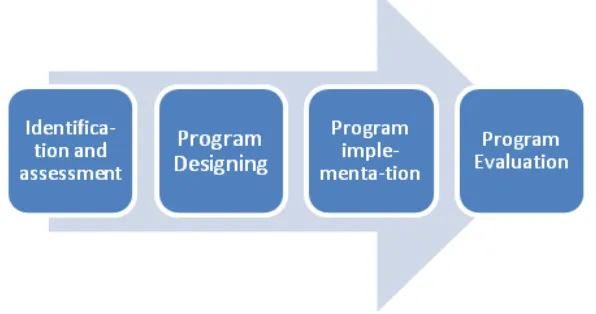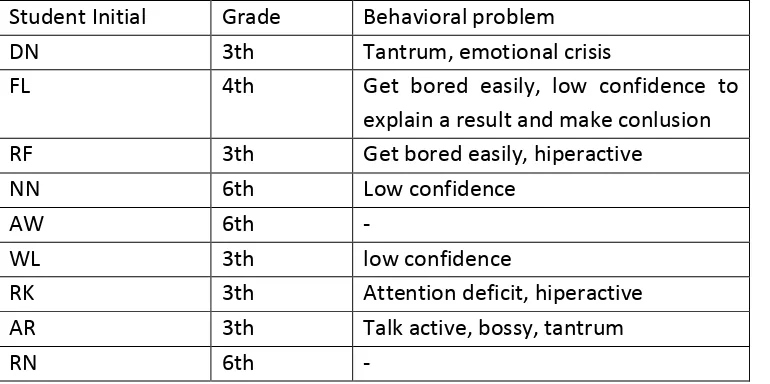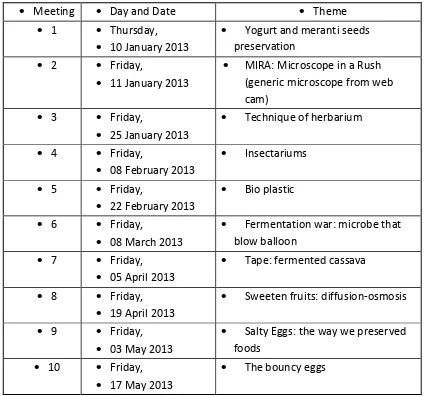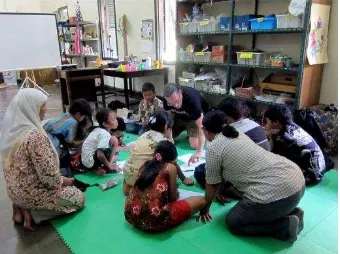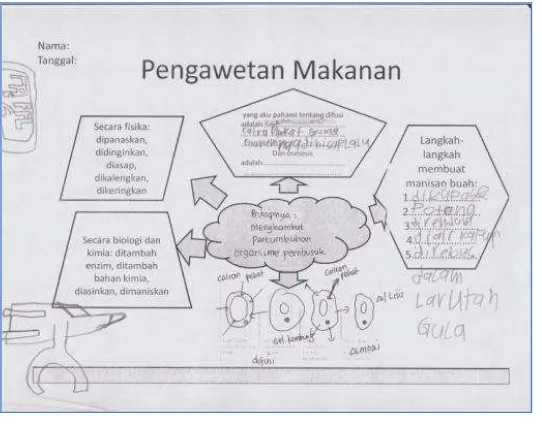Page 432 of 464
BIOTECHNOPRENEURSHIP:
AN INTRODUCTION OF BIOTECHNOLOGY AND ENTREPRENEURSHIP
PROGRAM
IN ADDRESSING BEHAVIORAL PROBLEMS OF GIFTED CHILDREN
FROM TUMBUH INCLUSIVE ELEMENTARY SCHOOL, YOGYAKARTA, INDONESIA
Wahyu Wido Sari 1); Admila Rosada 2)
1) Sanata Dharma University,Mrican, Yogyakarta 55002, Indonesia
2) Gadjah Mada University, Jl. Humaniora Bulaksumur, Yogyakarta 55821, Indonesia
e-mail:1) [email protected]; 2) [email protected]
Abstract
Tumbuh Inclusive Elementary School is one of inclusive school at Yogyakarta that facilitates special needs student in their learning activity. The school creates Individual Educational Program (IEP) to gain special needs student competencies as their needs including gifted students. The school looks the importance of designing special program for gifted because they show some behavioral problem in daily activity at school such as tantrum; get bored easily, hiperactive, and emotional crisis. The aim of this program is to i i ize the so ial i pa t of gifted hild e s eha io al p o le s to a ds the othe children by conducting activities that stimulate their experience and knowledge in biotechnology and its implementation. The biotechnopreneurship program consists of activities that introduce the way of human being in processing food materials or environment which produces valuable products. The program decreased behavioral problem of gifted children because the superior cognitive capacity was balanced with soft and social skills. The program conducted for 9 gifted children with durations of 10 meetings which carried out biweekly for one and a half hour.
Page 433 of 464
couldnot remember the experiments detail. One student did not show any changing of his problem.
The follow up of this activities, we will lead this program to entrepreneurship by motivated the students to make their own biotechnology product as have been taught to them this semester. Then, they will sale those products to their classmate or in school fair.
Keywords: biotechnology, inclusive education, gifted, behavioral problems.
Introduction
No ada s, people s a a e ess of i lusi e edu atio has rapidly developed in Indonesia. More schools adopt the inclusion system which facilities normal children and also children with special needs. Children with superior intellectuality or usually called gifted children are also considered as the special need children, which require special treatment. Their superior intellectual capacity, which is shown by their broad knowledge and good problem solving skill, in fact is not optimally facilitated by the school. As consequences, in class, gifted children get bored easily and distracted because their aspiration and energy are not fully facilitated. Furthermore, they show some behavior problems.
Page 434 of 464
Indonesia government has several regulations as basic to conduct special education, they are: a) Section 32 UU no 20 year 2003 Sisdiknas that accommodates children with physical impairment, emotional problem, social problem, and giftedness, also students from left behind villages, disaster victims, and low economy; b) Section 5 UU No 20 Year 2003 Sisdiknas mentioned that every citizen has their own right to get qualified education, including children with characteristic as written at point a. Then, Indonesia government creates National Education Ministry Regulation No 70 Year 2009 about inclusive education for students with impairment and students with giftedness. There are 10 sections that arrange the practical framework until province and district level.
Inclusive education according to the Minister of National Education Regulation (Permendiknas) No. 70 year 2009 is defined as an education system that provides opportunities to all students with SEN and special talents and/or intelligence to have access to education or learning in an educational environment together with other students. In its application, inclusive education aims to provide as many opportunities as possible to students with SEN and develop education that recognizes diversity and non discriminatory towards all students with physical, emotional, mental and social limitations as well as those student with special talents and/or intelligence so they can receive quality education according to their needs and abilities (Aznam, 2012).
Significant momentum has also been built in Indonesia, especially in Yogyakarta has responded with the creation of regulations specifying inclusion. These regulations include Provincial Education Plan (PERDA) approved on 12 May 2011and plans to create a provincial regulation on inclusive education are underway. Yogyakarta municipality already has a local regulation establish in 2008 and regent regulation on inclusive education are planned for the district of Gunung Kidul, Bantul, and Kulon Progo. The provincial government created several regulations specifying inclusion such as a Provincial Education Plan and a provincial regulation on inclusive education. Education authorities have worked together with the parliament and Planning and Development Agency (Badan Perencanaan Daerah) to budget funds for accessibility in schools. Furthermore, the provincial education authority has taken steps to revitalize the inclusive education resource center in the province and plan for the establishment of 5 further sub-centers at the district level.
Page 435 of 464
modifications or accommodations to the curriculum. In addition, research indicates that gifted students allowed working on additional material instead of maintaining the pace of the rest of the class actually performed better on end of the year testing in math and science than gifted controls that did not pursue additional work. Further, the gifted students who engaged in independent study performed no differently in other subject areas. The implication is that one method of improving student math and science performance is to allow for accelerated and/or enriched curricula.
Tumbuh elementary school is an inclusive school that located at Yogyakarta, Indonesia under Yayasan Edukasi Anak Nusantara (YEAN). The school starts the learning activity at 2005. Now they have already 3 elementary schools and 1 junior high school with all 425 students.
The vision of Tumbuh Incusive School is children grow as lifelong learners, have respect for diversity and local wisdom, love the mother land and show awareness to be part of universe. Tumbuh Inclusive School has deep philosophy in learning that school must be fun for both students and educators; students and educators must enjoy learning as a life long journey; and students have sense of belonging to the learning. In conducting learning program, Tumbuh Inclusive School uses national curriculum KTSP (Kurikulum Tingkat Satuan Pendidikan) and also Cambridge Curriculum as enrichment. They also design Individual Education Program (IEP) for special need students.
Differentiation of the curriculum represents the baseline strategy for dealing with an ide tified “EN. The app oa h has ee defi ed as tea hi g thi gs diffe e tl a o di g to observed differences among lear e s West ood, . It is i po ta t to ote that differentiation in the curriculum is one of the bases of effective generalist teaching. It has assumed significant importance in SEN, it remains applicable across the entire curriculum and at every level of the achievement spectrum. Fundamentally, therefore, it represents recognition that learners are individuals. It is derived from a number of pedagogical approaches, notably those of task analysis, curriculum monitoring and review, pupil grouping, and learning and teaching styles. Differentiation is a relatively straight forward term to define; most teachers will agree that, because it relates to an input process output model of teaching, it is not easy to put into practice (Philip, 2009).
Page 436 of 464
compare with other conceptions, how should gifted individuals be identified, how should gifted individuals be instructed in school and elsewhere, and how should the achievement of gifted i di iduals e assessed? “te e g & Da idso , , p. i .
Differentiation of the curriculum for gifted students is the best way to optimize their potential. Usually gifted students have high interesting in science and technology. One of the themes in recent science and technology is biotechnology. Biotechnology is a sample of modern science which provides teachers with a context to show how teams of scientist, technologist, and social scientist work together. It also provides opportunities for students and teachers to explore and critically debate and dilemmas in ethical issues that arise during the process (Phoenix in France, 2007). Furthermore the social and political issues arising from the practice of biotechnology provide a rich context to link science with the life world of the students.
Biotechnology has been a part of human history for thousands of years and perceived as an indicator of prosperity and development (Kwon, 2012). This study was improving the quality of our daily lives such as food, health, fuel, and environment. The growing impact of biotechnology globally and nationally over the past few decades has promoted the need for elevating general biotechnology literacy levels in all populations (Kwon, 2012).
Et ologi all , iote h olog ea s the stud of tools f o li i g thi gs , combining the Greek words io li i g o ga is o life , te h o a t, skill, s ste o
tool , a d logos spee h, stud of Wells o K o . We a o lude that
biotechnology is any technique that uses living things (organism or part of organism such us enzyme, gene) to make or modify products, improve them, or develop them for specific uses.
Indonesian people recognized local biotechnology such as fermentation for long time. Tempe, tape, yogurt, kefir, salty eggs, pickled vegetables are local cuisine as biotechnology product. Modern biotechnology is central to human innovation and our future. Public knew about genetic modified organism (GMO), but they didnot have enough scientific knowledge to understand it. There is a tension about the GMO. As biotechnology develops to molecular genetics, began a large gap between scientists with general public. Communities with limited understanding about biotechnology and science have to deal with conflict between commercial and politic.
Page 437 of 464
food for which there was no perceived urgency and anyway there were plenty of other options, the safest cores seemed to be maintain a healthy distance.
Again, Moses, 2003 explained that the problem of disseminating information exists at two levels: addressing the adult electors of today and ensuring that the voters of tomorrow have a good grasp of important issues through the normal processes of educating children and young people.
Biotechnopreneurship is a program that we set up to introduce biotechnology to children. We hope with this program 9th gifted students from Tumbuh Inclusive School can be an agent to biotechnology to public and they can figure their behavior as their difficulties to lea i lass. This p og a is ai ed to i i ize the so ial i pa t of gifted hild e s behavioral problems towards the other children by conducting activities that stimulate their experience and knowledge in biotechnology and its implementation. The biotechnopreneurship program consists of activities that introduce the way of human being in processing food materials or environment which produces valuable products. This program was a pilot project which have been evaluated and considered as alternative activities that facilitate the needs of the students in the inclusive school setting.
The biotechnopreneurship program contains an introduction of microorganism, concept of fermentation, preservation of foods and generic laboratory equipments workshop.
MATERIALS AND METHOD
To gain the best practice in inclusive education and facilitating gifted students, Tumbuh Inclusive Elementary School in Yogyakarta – Indonesia creates biotechnopreneurship program. The principal and its center for studies on inclusive education did this process:
Page 438 of 464
The identification and assessment process was done by teacher recommendation and the IQ testing. From this process, Tumbuh Elementary school has 9 gifted students, but 1 student has to move to Australia so he only joined 3 sessions. Then Head of Schools and principals did corporation with biotechnology mentor to conduct this program. They designed biotechnology for young learner program to be implemented in second semester academic year 2012-2013. At the end of the program, they will evaluate all of the process to get do the next program.
Table 1 Data of students with their behavioral problem
Student Initial Grade Behavioral problem
DN 3th Tantrum, emotional crisis
FL 4th Get bored easily, low confidence to explain a result and make conlusion RF 3th Get bored easily, hiperactive
NN 6th Low confidence
AW 6th -
WL 3th low confidence
RK 3th Attention deficit, hiperactive
AR 3th Talk active, bossy, tantrum
RN 6th -
The program conducted for 9 gifted children with durations of 10 meetings which carried out biweekly for one and a half hour.
The introduction of biotechnology was begun with fermentation of yogurt and built generic microscope from web cam. The theme of this semester was preservation. We introduced the concept of preservation of their samples or their foods.
We prepared module to guide the experiment because we used inquiry based learning model. The students were guided with a problem or question, then we arranged an experiment (explanation the experiment), the students collected the data and we got them with post test. The teacher observed them during the experiment.
Page 439 of 464 Observations were done at biotechnology class every two weeks. Observation guideline was constructed based on the scientist attitude such as concentration, work in tidy, observation skill, scientific questioning, and constructing hypothesis. Questionnaire was fulfilled by the teachers that the gifted students are studying in their class. The teachers wrote the diffe e es of stude t s attitude efo e a d afte the p og a . The uestio ai e t pe is open questio to gai ualitati e data a out stude t s attitude i the lass.
Page 440 of 464
Indonesia, Our Earth, Technology and Innovation, and Entrepreneurship. The main units are implemented into certain topic of inquiry based on the curriculum competencies and concerning the recent issues. Then, these inquiry themes are deducted into learning method. The learning methods are wondering and questioning, experimenting, researching & seeking information, collecting data and reporting findings, deepening understanding through the application, making and testing hypothesis, and elaborating on solutions to problems.
This program has been running 9 times out of 10 meetings scheduled. A major theme in this semester is preservation. Logbook as scientific journal has been introduced in the first meeting. Based on our observation, students did not realize the importance of logbook as experiment record. They wrote down their observation during experiment if the teacher said so.
The first meeting we introduced to students the way to preserved meranti seeds and preserved milk as yogurt. We introduced to them that there was a microorganism had spoiled the milk but it still could be eaten. One of the students (DN) refused to join with the group and run. But, when he knew that his friends made yogurt in the kitchen by themselves, he was keen to join. This student has behavior problem tantrum. He grew up in a violent household. His teacher gave up by his tantrum behavior in class. But, in this program, he was only once run and back to the class in the first meeting.
Second meeting we got Dr. Marc D from Lifepatch. He taught students to built generic laboratory equipment from simple tools. The students built microscope from web cam and observed microorganism. They named the organism they saw by the generic microscope with bubuflufu or microflea bubuflufu, actually we observed water bug.
Page 441 of 464
Fig Mi oflea u uflufu ate ug o se ed ith ge e i i os ope
In this meeting, the students followed all the activity nicely. They contributed to finished their previous activities that had been hold yesterday, made yogurt. They also did their post test by draw their microorganism observed by generic microscope and named it.
“tude ts high i te est i iote h olog a d s ie e a e e high. The ould understand and completed the difficult task of fermentation or built generic equipment quickly and well managed. We taught them about the generic equipment as their curiosity of biotechnology was high. Biotechnology represents an important field for the development of new educational tools. While the activities are very brief and simple its value of clearly visualizing and illustrating the basic techniques of biotechnology concepts cannot be disputed (Antiparmak and Yazici, 2010).
The third meeting, the students practiced to made herbarium. Herbarium is a method to preserved botanical samples. The samples were taken from the garden. The students looked for leaves with different shapes and edges. RK, RF, and DN took this opportunity to go out other activities such as played football or picked fruits and flowers. Once they got back to the laboratory, they started did their herbarium sheet. They improved their sheet by painted them with colorful paint.
The fourth meeting, the students learned to made an insectariums preserved. This method was more complicated than herbarium. They had to killed the insect by injected the insect with alcohol. The boys were very interested with this technique, but the girls became stressful. AR escaped twice from laboratory as frightened with the insects. RK improved his worked by poured a lot of alcohol in his insects o , so the i se t e a e spoiled the da after. Their herbarium and insectariums was displayed at Tumbuh Inclusive School open house. As the entrepreneurship program, they will make preserved sample to be sold in school fair.
Page 442 of 464
The students learned to proved single cells creatures involved in the fermentation p o essed. We o du ted a e pe i e t p o i g the i o ial Mi o es that lo the alloo e pe i e t. Yeast is a si gle elled fu gus that o e ted glu ose i to al ohol a d carbon dioxide in the microaerophilic conditions. The students witnessed the gas produced by the yeast by observed at the balloon inflated. They recognized that fermentation was occured by the flavor of the sugar liquid changed into fermented flavor like tape. We observed that FL and RK have interested with this theme. FL wrote in his logbook about the ti e afte ti e of gas fo atio . This is FL s itte a out the ti e of gas fo atio du i g
(10 minutes: the balloon have increased in volume) (30 minutes: the balloon increased bigger that before)
This program was not connected with their curriculum and lesson. FL teacher observed that by this program, FL increased her confidence to explain something and helped her classmates. FL already knew the experiments steps. But after join this program, FL understood the experiments steps, more enthusiastic in science experiment lesson and good to drag a conclusion.
We introduced how amazing some microorganism did in our live and how they gave very much advantages. In the present study, before we did the experiment, the students have asked about their perception concerning the microorganism. All the students in this program defined microorganism as harmful. That opinion and perceptions were relevant with Karadon dan Sahin research in 2010. They found that 53 % of the students in 17 different primary school defined microorganism as dirt pollutant, and harmful. Most of students think that the risks of microorganisms are more than their benefits, and they stated that they feel bad when they hear the word microbe or microorganism. After we have done the fermentation experiment, students understood that there was microorganism that gave more benefits than the risks. WL explained it to her parents at home after this program.
The students learned about local fermentation by made tape (fermented cassava) in the seventh meeting. They did post test briefly. The tape they had made was good and tasty. Their parents and teachers tasted the tape they made.
Page 443 of 464
eggs. We also made a post test and the students managed to do it well. In the eighth meeting, we made sweetened fruit (zalaca and papaya).
Fig “tude ts post test a out diffusio a d os osis
The students made salty eggs in ninth meeting. That was the last meeting we have done, once meeting left.
Page 444 of 464
Conclusion
Biotechnopreneurship as pilot program of Tumbuh Inclusive School for gifted students showed a good result. The behaviors of the students influence to be better. Based on our observation, there is no clear linkage between the program activities in class activities. But, three students showed their influence to made conclusion during their experiment class activity. Two students assist the teachers in class and able to re-tell the experiment of biotechnopreneurship but they cannot remember the experiments detail.
The follow up of this activities, we will lead this program to entrepreneurship by motivated the students to make their own biotechnology product as have been taught to them this semester. Then, they will sale that product to their classmate or in school fair.
Acknowledgment
We wish to express our appreciation to our colleagues: Yayasan Edukasi Anak Nusantara, Center for Studies on Inclusive Education, Sekolah Tumbuh Yogyakarta, Elga Andriana, S.Psi, M.Ed, and Sri Aryaningsih, ST. Finally, we thank all of students who participated in this program.
References
Antiparma, M. And Yazici, NN. 2010. Easy biotechnology: Practical material design within team activities in learneing biotechnological concepts and processes. J Procedia Social & Behav Sci 2: 4115-4119
Aznam, Nurfina. 2012. Teaching in Differentiation and Learning Strategies: Implementation of Science in an Inclusive School, SMP Tumbuh Yogyakarta, Indonesia. Yogyakarta: Yogyakarta State University.
France, Bev. 2007. Location, Location, Location: Positioning Biotechnology Education for the 21st Century. J Stud Sci Edu 43:88
Gardner, Philip. 2009. Special Educational Needs: The Key Concepts. London and New York: Routledge.
High Level Meeting of Mayors for Inclusive Cities: as pa t of UNE“CO p oje t “o ial I lusio
of Pe so s Li i g ith Disa ilities i I do esia. 2013. Yogyakarta, Indonesia.
Page 445 of 464
Kwon, Hyuksoo. 2009. Key Factors Affecting the Implementation of Biotechnology Instruction in Secondary School Level Technology Education Classrooms. [Disertation]. Virginia Polytechnic Institute: Virginia
Moses, Vivian. 2003. Biotechnology education in Europe. J Commercial Biotechnol 9:3:219
Robertson, Stephanie Glenn. 2012. Initial Development of a Procedural Guide for
Implementing Response to Intervention with Gifted Elementary School Students. The Florida State University: College of Education.
